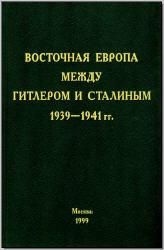Восточная Европа между Гитлером и Сталиным. 1939–1941 гг. М., 1999.
Восточная Европа между Гитлером и Сталиным. 1939–1941 гг. М.: Индрик, 1999. – 528 с.
Отв. ред. В. К. Волков, Л. Я. Гибианский.
В коллективной монографии анализируется совокупность международных проблем в Восточной Европе в 1939–1941 гг. в контексте отношений между Германией и Советским Союзом – двумя основными полюсами, определявшими судьбу восточноевропейских стран на начальном этапе второй мировой войны. На основе исследования широкого круга источников, среди которых важное место занимают новые материалы из отечественных и зарубежных архивов, дана многоаспектная картина причин и механизма подчинения или захвата восточноевропейских государств нацистской Германией (частично вместе с фашистской Италией) и, соответственно; тяжелого внешнеполитического поражения СССР накануне гитлеровского нападения на него.
Содержание
От редакции
Введение
Глава I. Страны Восточной Европы в водовороте событий накануне второй мировой войны
Глава II. Гитлер, Сталин и генезис четвертого раздела Польши
Глава III. Германо-советское взаимодействие и ликвидация польского государства
Глава IV. Словакия в политике СССР и Германии
Глава V. Балканские проблемы в отношениях Советского Союза и Германии в 1940 г.
Глава VI. Румыно-венгерский конфликт в контексте германо-советского соперничества
Глава VII. Румыния между Германией и Советским Союзом: политика без иллюзий
Глава VIII. Болгария в советско-германских противоречиях на Балканах
Глава IX. Югославия перед лицом фашистской агрессии и Советский Союз
Заключение
Список сокращений
Указатель имен
Eastern Europe between Hitler and Staiin, 1939–1941 / Ed. by Vladimir Volkov and Leonid Gibianskii
The present collective monograph deals with entire complex of international problems of Eastern Europe (or Central and South-Eastern Europe) through the prism of relations between Germany and the Soviet Union as two main poles which determined the fate of East European countries in the initial stage of the Second World War. The research is based on a great number of documents, including numerous new materials from Russian, German, East European and the USA archives. The authors shed a new light on the reasons and mechanisms of subjugation or capture and occupation of East European states by the Nazi-ruled Germany (partly together with fascist Italy) on the one hand, and of the Soviet foreign policy defeat on the eve of Hitler's aggression against the USSR on the other.
Contents
Editorial Foreword
Introduction (Leonid Gibianskii)
Chapter I. East European Countries in the Whirl of Events on the Eve of the Second World War (Vladimir Volkov)
Chapter II. Hitler, Stalin, and the Genesis of the Fourth Partition of Poland (Sergei Sluch)
Chapter III. German—Soviet Interaction and the Abolishment of Polish State (Natalia Lebedeva)
Chapter IV. Slovakia in the Soviet and German Policies (Valentina Mar'ina)
Chapter V. Balkan Problems in the Relations between the Soviet Union and Germany in 1940 (Vladimir Volkov)
Chapter VI. Romanian-Hungarian Conflict in the Context of German-Soviet Rivalry (Tofik Islamov and Tatiana Pokivailova)
Chapter VII. Romania between Germany and the Soviet Union Policy without Illusions (Margarita Yereshchenko)
Chapter VIII. Bulgaria within the Soviet-German Contradictions in the Balkans (Yelena Valeva)
Chapter IX. Yugoslavia in the Face of Fascist Aggression, and the Soviet Union (Leonid Gibianskii)
Conclusion (Vladimir Volkov and Leonid Gibianskii)
List of Abbreviations
Index of Names

